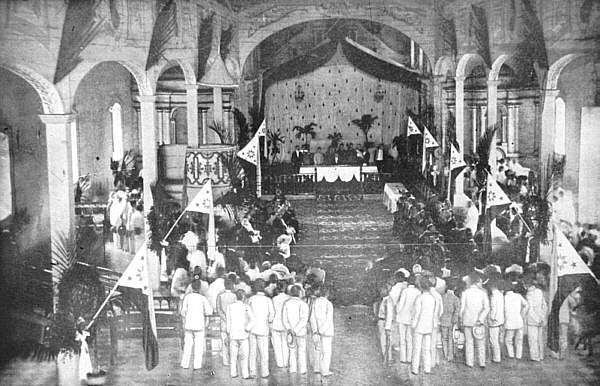Type Unicameral Disbanded November 13, 1899 | Founded September 15, 1898 Succeeded by Taft Commission | |
 | ||
Houses La Asamblea De Representantes Preceded by Spanish Cortes
Ayuntamiento | ||
The Malolos Congress or formally known as the "National Assembly" of representatives was the constituent assembly of the First Philippine Republic. It met at the Barasoain Church in Malolos City, Bulacan. It drafted the Malolos Constitution.
Contents
- Political Constitution
- Sessions
- Leadership
- Council of Government Cabinet Members
- Members Representatives
- References
The Congress was not much more than a decoration. "That is to show to the foreign correspondents that we Filipinos are civilized, but the bulk of the work in nation building were done at the Malolos Cathedral by the executive branch of government led by (Philippine President Emilio) Aguinaldo, who was in command of the army fighting the Americans," said attorney Cris Santiago, past president of the historical society of Bulacan (known as Samahang Pangkasaysayan ng Bulacan or Sampaka).
Political Constitution
Following the declaration of independence from Spain on June 12, 1898 and transformation of the dictatorial government to a revolutionary government on 23 June, the Malolos Congress election was held between June 23 and September 10. On 15 September 1898, the revolutionary congress convened in Barasoain Church in Malolos (now Malolos City, Bulacan) with Pedro Paterno as president and Gregorio S. Araneta as vice president. On 29 September, the 12 June Declaration of independence was ratified. The congress then decided to draft a Constitution, a decision opposed by Apolinario Mabini, the Prime Minister of the revolutionary government (President of the Council of Government). The resulting Malolos Constitution was ratified on November 29, 1898, signed into law on December 23, approved on January 20, 1899, sanctioned by President Emilio Aguinaldo on January 21, and promulgated on January 22. The document states that the people have exclusive sovereignty. It states basic civil rights, separated the church from the state, and called for the creation of an Assembly of Representatives (A.K.A. National Assembly) which would act as the legislature. It also calls for a parliamentary republic as the form of government with the president elected for a term of four years by a majority of the Assembly.
Sessions
Leadership
Council of Government (Cabinet) Members
The cabinet only met in a few times in 1899.
Members (Representatives)
In 2006, engineer Marcial Aniag, president of the Bulacan Historical Society, asserted that among the 85 delegates who convened in Malolos there were 43 lawyers, 17 doctors, five pharmacists, three educators, seven businessmen, four painters, three military men, a priest and four farmers. Five of the 85 delegates did not have a college degree.
List of National Assembly Representatives (members) by province as of July 7, 1899.
*Modern-day Republic of Palau.
**Renamed to Antique.
***Currently parts of Palawan, Paragua corresponding to mainland Palawan.
